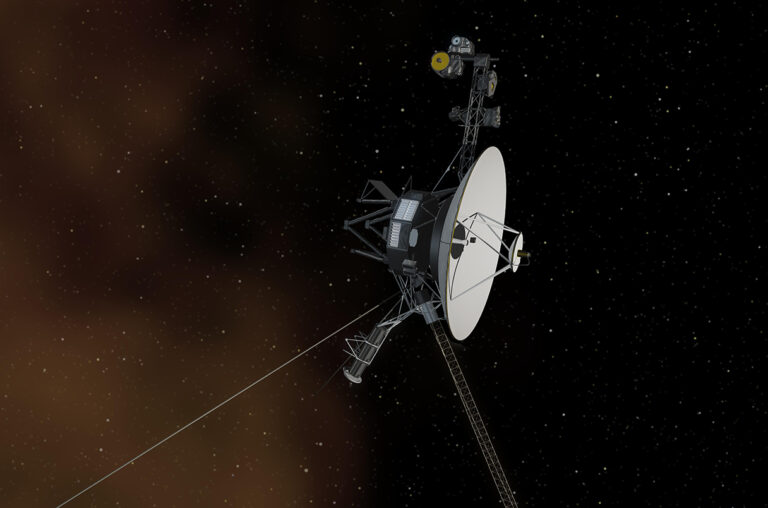Voyager 1 data stream continues after interstellar space crisis.
Before the probe’s computer system died, the venerable NASA probe may have entered an unexplained new realm of space, beyond the solar system.
NASA’s Voyager 1, one of the long-serving twin spacecraft that traveled to interstellar space, has finally sent signals back to home planet after radio silence for half year. After a corrupted chip event in November 2023, engineers returned the spacecraft to operation, which initially transmitted engineering data and then began sending science reports for two of the remaining four Voyager instruments on 17 May.
This was a moment of optimism, said Jamie Rankin, an astrophysicist at Princeton University and Voyager’s deputy project scientist. NASA intends to switch on the other two pieces of equipment on Voyager 1 in the next few weeks. During their 47-years long voyage to the outskirts of solar system and beyond, both Voyagers had their fair share of problems. However, the communication breakdown experienced by Voyager 1 recently was rather exceptional as stated by Alan Cummings, a Caltech physicist, and the 51-year Voyager veteran.
Before the data-gathering was disrupted, Voyager 1 had been sailing through what researchers believe could be a vast wave of pressure or perhaps a cloud of primordial plasma and scientists are hungry for more.
The Voyagers were Launched in 1977 and returned the first enhanced images past Mars, the Great Red Spot of Jupiter, the spectacular sight of volcanic activity on jovian moon Io and finally the blue storms of Neptune’s atmosphere. Having documented their task, the probes went on to the outskirts of the heliosphere – a plasma formation, which the Sun blows around the Solar System. Voyager 1 left the heliosphere in 2012, marking the first human-made object to venture into interstellar space. Voyager 2 made the same journey in August 2018.
They contain electric generators that operate on heat from decaying plutonium and the craft has only 6 years of power left which is quite a concern. Mission managers have turned off six of the ten instruments that were on board the Voyager when it was launched. Now that the spacecraft is beyond the heliosphere, the vehicle’s electronics are also exposed to impacts from galactic cosmic rays, which are high energy charged particles produced by supernovae and other astrophysical processes.
That is the hypothesis of NASA concerning such actions of the Voyager 1 on the last of November, when the space probe started to send a sequence of random binary code. In response, the emergency engineering team quickly went to work to diagnose the problem and proceed with commands to the probe, which was nearly a light-day away. They had to study for several decades of documentation left behind by retired or even dead engineers in order to understand how the system worked.
At the end of the investigation, the team found out that the problem was originating from a memory chip that contained an essential communication program. They then split the functions originally handled by the chip’s memory to the rest of the memory of the computer, selecting the commands needed for engineering data, then, after due deliberation, commands for scientific data. At one point, there was some doubt as to whether everything would fit into memory, as Rankin has mentioned.
Before this decline, Voyager 1 had been involved in investigating a rather enigmatic event. The magnetometer of the spacecraft observed a jump of the magnetic field strength in the rare interstellar plasma in 2020, at the same time the plasma detector recorded an increase in the plasma density. While such deviations were not unprecedented, they were often short-lived and reversed themselves within a period of several months. Experts suggest that these slight spikes happen when plasmas from the Sun erupt and hit the heliopause, creating waves that propagate through the interstellar medium, interacting with and compressing interstellar plasmas and their respective magnetic fields. In the words of Adam Szabo, an astrophysicist at NASA’s Goddard Space Flight Center and the magnetometer’s principal investigator, the source of these phenomena is like a piston.
Anomalies that began in the year 2020 have not stopped and, for this reason, some of the mission scientists have doubted the origin of the anomalies saying that they emanate from the sun. As pointed out by Szabo, these may be suggestive of the fact that Voyager 1 is now in a small dense core of ancient interstellar plasma having the stronger field which emanates from a star or a star-forming region. At the moment, the scientific community is anticipating the data from the two instruments to know if they are still picking increased field intensity and plasma densities after 6 months of inactivity. This could indicate that Voyager 1 is still passing through the cluster hence morphing it into a vast region as explained by Szabo.
Szabo’s hypothesis is one of the possibilities that might explain these observations. While some claim that the newly found area is simply a solar pressure wave, the largest one ever observed. Others argue that such observations support their claims that Voyager 1 has not left the heliosphere.
The thing is that the situation analysis will be difficult. According to Stella Ocker, a postdoctoral fellow at Caltech and the Carnegie Observatories, the biggest challenge astronomers encounter while observing objects in space is to capture the interstellar medium between our Solar System and the target data. CHIKA ONUBOGU, a Boston University Ph. D. astronomy learner, opines that Voyager belongs to both astro- and space-physics. Nonetheless, Voyager scientists insist that it is important to note the opportunities provided by the information gained. One such goal is future long-range space missions Kostas Dialynas, an astrophysicist at the Academy of Athens. Recent activities of Voyager 1 is a reason for joy for the scientists because they travel in the unknown waters with no idea of what is ahead.
Do not forget to share your opinion with us to provide you with the best posts !




0 Comments